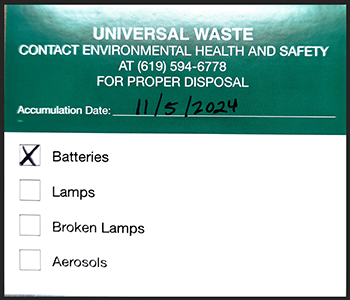Universal Waste
Universal Waste
Common universal wastes include but are not limited to batteries, lamps, aerosol cans (full or empty), mercury-containing items like thermometers and thermostats, and electronic waste. Universal waste has low-level hazard properties and cannot be put into the municipal trash.
- While in transport and storage, universal waste must be in containers compatible with the waste; for example, cardboard boxes are sufficient to contain used lamps. The container must be closed when in storage and opened only when materials are being put into them.
- A universal waste container must be labeled properly with “Universal Waste”, the identity of what is inside the container, and the date the first item of universal waste went into that container. The label must be attached before the first waste item goes into a container.
Universal waste needs to be removed by EH&S when the container is full or has reached its nine-month accumulation time. Accumulation time is based on the date written on the container’s universal waste label.

Submit a universal waste removal or a universal waste label request by submitting a Hazardous Waste request in BioRAFT/SciShield or email [email protected].

